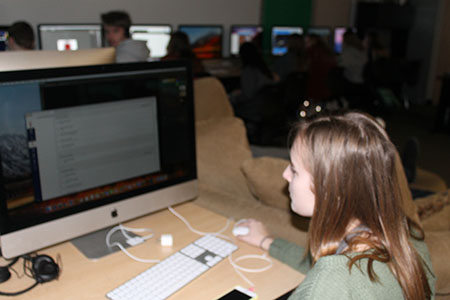Teachers begin experimenting with new classroom tool

Sophomore Kaitlyn Johnson uses Canvas to work on her assignments for one of Drew Proctor’s classes.
Recently, many teachers from De Soto High School have been experimenting with Canvas, a new learning tool that will be replacing Blackboard in the upcoming school year. Although most are still getting used to the program, these teachers have an overall positive view of Canvas and are working to merge their classroom assignments with this online tool.
Being introduced to Canvas and becoming familiar with the program was challenging at the beginning for some DHS teachers, as all new initiatives generally are. Many of them have noticed problems regarding their students’ access to the software.
“My experience has been pretty smooth. At the beginning of the year, there were some issues with students not having accounts, but this was part of a pilot basis, so that can be expected,” said CTE Teacher Drew Proctor, who was one the DHS teachers piloting the new system. “After some of the set-up was finished, everything definitely ran smoother. It has definitely been a learning curve for both myself and my students, but once they get used to it, it’s pretty easy to pick up on things.”
Because all of their classes are so different, the teachers who have begun to experiment with Canvas use it in different ways. Band teacher Matt Bradford has started to use Canvas for his students’ instrument playing tests.
“We’ve started using it [Canvas] in the band world. We’ve already started putting assignments in, and the students are slowly taking to it,” Bradford said. “We are going to do all of our playing tests on Canvas now, and so far it’s been really easy.”
Once she got the hang of the program, English teacher Donna Rhodes began testing out certain features on Canvas as a way to bring online assignments to her curriculum.
“So far, I have only used it for an online discussion,” Rhodes said. “However, I am looking forward to exploring many other options.”
This new learning tool has affected Proctor’s classroom the most, as he feels that it has significantly benefited his students’ classroom work time.
“My class is a little bit different than most classes. Since a lot of my class is project-based, the way I teach is quite different. Before, if there was an issue in my class, I would stop, go help a student, but then every other student would be sitting and waiting for me to finish helping that student. Now with Canvas and my tutorial videos, students can go through my class at their own pace to complete assignments,” Proctor said. “I believe that they appreciate this and I think that they learn more by being able to complete assignments at their own pace.”
Although used in the same way, Canvas and Blackboard are noticeably unlike. The main difference that teachers have noticed between the two is their design and level of ease.
“I feel that Canvas is a lot more user-friendly. I don’t mind admitting that it took me a very long time to feel comfortable and confident using Blackboard,” Rhodes said. “My learning curve [with Canvas] has not been as frustrating as I experienced with Blackboard. Also, Canvas is much easier for me to troubleshoot than Blackboard. I have usually found my problems are silly user errors.”
Bradford agrees, also feeling that his students have been more open about using Canvas, while many hardly ever utilized Blackboard.
“Students didn’t really use Blackboard for whatever reason. I don’t know if it seemed bulky and clunky, but students didn’t seem to like it, even though I encouraged them to use it,” Bradford said. “For whatever reason, I’m looking at Canvas and it looks easier and more simple.”
Proctor has taken note of some of the more specific, little details that make Canvas easier and more user-friendly, especially the ones that contribute to his class in particular.
“In Canvas, when teachers post something, it posts in multiple places. In Blackboard, teachers have to post the same thing multiple times to make it easier for students,” Proctor said. “I also really like that teachers are able to embed other technology tools to Canvas, which would also allow students to not have to leave Canvas in order to use them. It even has a portfolio feature that would allow students to take their work and create a digital portfolio and send to colleges if one is needed.”
Overall, the reaction from teachers has been positive, and many of them are excited about using the tool in the future.
“I am planning on using Canvas more extensively and regularly in the future. As I have more time to explore and figure out how to use the options, I think it will be an invaluable aspect of my classroom,” Rhodes said.
“Like all technology tools, it takes some time to get used to,” Proctor said. “But looking forward, it will be much easier to use for both teachers and students.”

Meet Ella Fixsen, Editor in Chief. This is Ella’s senior year, as well as her third year on staff. She has previously worked on the Green Pride as a...

